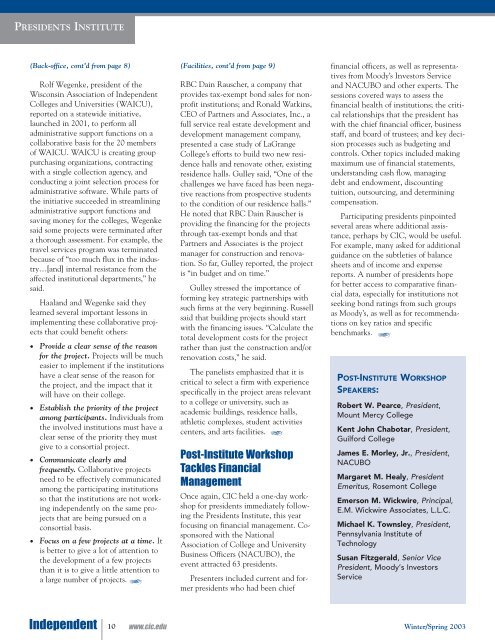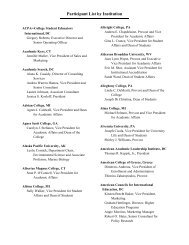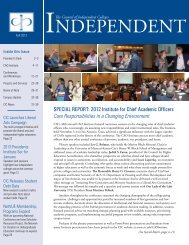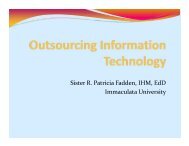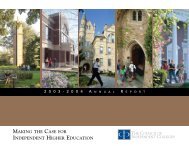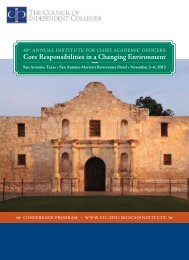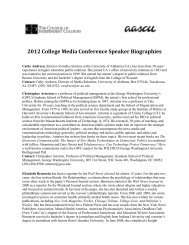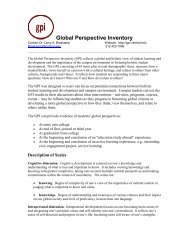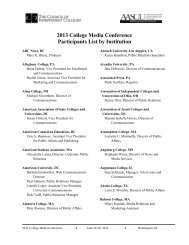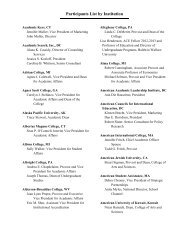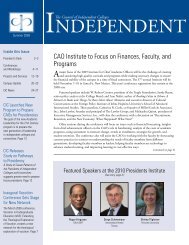Winter/Spring 2003 - The Council of Independent Colleges
Winter/Spring 2003 - The Council of Independent Colleges
Winter/Spring 2003 - The Council of Independent Colleges
- No tags were found...
Create successful ePaper yourself
Turn your PDF publications into a flip-book with our unique Google optimized e-Paper software.
PRESIDENTS INSTITUTE(Back-<strong>of</strong>fice, cont’d from page 8) (Facilities, cont’d from page 9)Rolf Wegenke, president <strong>of</strong> theWisconsin Association <strong>of</strong> <strong>Independent</strong><strong>Colleges</strong> and Universities (WAICU),reported on a statewide initiative,launched in 2001, to perform alladministrative support functions on acollaborative basis for the 20 members<strong>of</strong> WAICU. WAICU is creating grouppurchasing organizations, contractingwith a single collection agency, andconducting a joint selection process foradministrative s<strong>of</strong>tware. While parts <strong>of</strong>the initiative succeeded in streamliningadministrative support functions andsaving money for the colleges, Wegenkesaid some projects were terminated aftera thorough assessment. For example, thetravel services program was terminatedbecause <strong>of</strong> “too much flux in the industry…[and]internal resistance from theaffected institutional departments,” hesaid.Haaland and Wegenke said theylearned several important lessons inimplementing these collaborative projectsthat could benefit others:• Provide a clear sense <strong>of</strong> the reasonfor the project. Projects will be mucheasier to implement if the institutionshave a clear sense <strong>of</strong> the reason forthe project, and the impact that itwill have on their college.• Establish the priority <strong>of</strong> the projectamong participants. Individuals fromthe involved institutions must have aclear sense <strong>of</strong> the priority they mustgive to a consortial project.• Communicate clearly andfrequently. Collaborative projectsneed to be effectively communicatedamong the participating institutionsso that the institutions are not workingindependently on the same projectsthat are being pursued on aconsortial basis.• Focus on a few projects at a time. Itis better to give a lot <strong>of</strong> attention tothe development <strong>of</strong> a few projectsthan it is to give a little attention toa large number <strong>of</strong> projects.RBC Dain Rauscher, a company thatprovides tax-exempt bond sales for nonpr<strong>of</strong>itinstitutions; and Ronald Watkins,CEO <strong>of</strong> Partners and Associates, Inc., afull service real estate development anddevelopment management company,presented a case study <strong>of</strong> LaGrangeCollege’s efforts to build two new residencehalls and renovate other, existingresidence halls. Gulley said, “One <strong>of</strong> thechallenges we have faced has been negativereactions from prospective studentsto the condition <strong>of</strong> our residence halls.”He noted that RBC Dain Rauscher isproviding the financing for the projectsthrough tax-exempt bonds and thatPartners and Associates is the projectmanager for construction and renovation.So far, Gulley reported, the projectis “in budget and on time.”Gulley stressed the importance <strong>of</strong>forming key strategic partnerships withsuch firms at the very beginning. Russellsaid that building projects should startwith the financing issues. “Calculate thetotal development costs for the projectrather than just the construction and/orrenovation costs,” he said.<strong>The</strong> panelists emphasized that it iscritical to select a firm with experiencespecifically in the project areas relevantto a college or university, such asacademic buildings, residence halls,athletic complexes, student activitiescenters, and arts facilities.Post-Institute WorkshopTackles FinancialManagementOnce again, CIC held a one-day workshopfor presidents immediately followingthe Presidents Institute, this yearfocusing on financial management. Cosponsoredwith the NationalAssociation <strong>of</strong> College and UniversityBusiness Officers (NACUBO), theevent attracted 63 presidents.Presenters included current and formerpresidents who had been chieffinancial <strong>of</strong>ficers, as well as representativesfrom Moody’s Investors Serviceand NACUBO and other experts. <strong>The</strong>sessions covered ways to assess thefinancial health <strong>of</strong> institutions; the criticalrelationships that the president haswith the chief financial <strong>of</strong>ficer, businessstaff, and board <strong>of</strong> trustees; and key decisionprocesses such as budgeting andcontrols. Other topics included makingmaximum use <strong>of</strong> financial statements,understanding cash flow, managingdebt and endowment, discountingtuition, outsourcing, and determiningcompensation.Participating presidents pinpointedseveral areas where additional assistance,perhaps by CIC, would be useful.For example, many asked for additionalguidance on the subtleties <strong>of</strong> balancesheets and <strong>of</strong> income and expensereports. A number <strong>of</strong> presidents hopefor better access to comparative financialdata, especially for institutions notseeking bond ratings from such groupsas Moody’s, as well as for recommendationson key ratios and specificbenchmarks.POST-INSTITUTE WORKSHOPSPEAKERS:Robert W. Pearce, President,Mount Mercy CollegeKent John Chabotar, President,Guilford CollegeJames E. Morley, Jr., President,NACUBOMargaret M. Healy, PresidentEmeritus, Rosemont CollegeEmerson M. Wickwire, Principal,E.M. Wickwire Associates, L.L.C.Michael K. Townsley, President,Pennsylvania Institute <strong>of</strong>TechnologySusan Fitzgerald, Senior VicePresident, Moody’s InvestorsService<strong>Independent</strong> 10 www.cic.edu<strong>Winter</strong>/<strong>Spring</strong> <strong>2003</strong>


